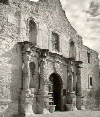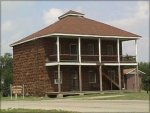"His summers are spent in campaigning; his winters in getting his horse in condition for the next campaign. He has scarcely a mounted drill for in summer he must save his horse for active work, and in winter his horse is unfit for it. He is building posts, stables, cantonments, driving a team or cutting firewood. He is a 'hewer of wood and a drawer of water.' That he can still contend with the Indian on anything like equal terms is his hightest commendation, for the Indian is his superior in every soldierlike quality, except subordination to discipline and indomitable courage."
--Colonel Richard I. Dodge, writing in 1882 of the western cavalryman.

In Alphabetical Order
Check also:
Forts in Texas Old West Forts and Towns in Texas,
Stations Stops & Landmarks Along the Overland Trail
and
Landmarks & Sites Along the Trails West









 Overland Trail
Overland Trail